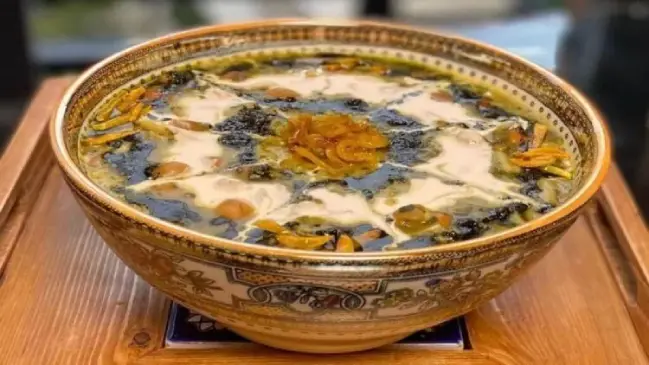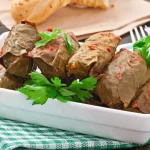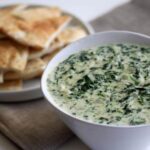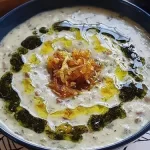Ash Reshteh is one of the traditional and popular Iranian dishes prepared with a variety of recipes in different cities of the country.
Due to its great popularity among Iranians, this delicious Persian noodle soup with herbs & beans is a staple of Iranian women, which is usually prepared with two general recipes, including noodle soup with curd and noodle soup with vinegar (pickled noodle soup).

You can prepare this delicious soup for the family on the cold days of autumn and winter, although eating Ash Reshteh is enjoyable on all days of the year, and we can not find anyone who does not love this food.
To see the complete cooking instruction and stage, follow the 14 steps of Ash Reshteh Recipe to prepare Ash Reshteh with CookingCounty.
Another Ash e Reshteh recipe:
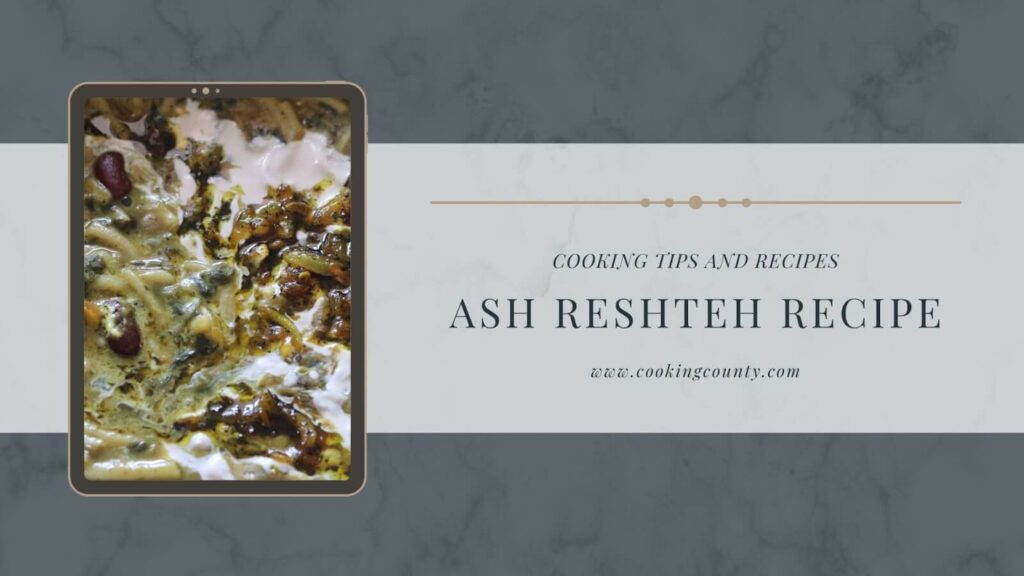
How to Make Ash Reshteh?
Ash Reshteh Ingredients
| Ingredient | Quantity |
|---|---|
| White beans | ½ cup |
| Pinto beans | ½ cup |
| Chickpeas | 1 cup |
| Lentils | 1 cup |
| Special vegetable soup | 500 grams (Spinach or beet leaves: 100 g Leek: 100 g Coriander: 100 g Parsley: 100 g Dill: 100 g) |
| Garlic | 8 cloves |
| Onions | 2 large |
| Dried mint | 2 tablespoons |
| Noodles | to taste |
| Curd | to taste |
| Salt and black pepper | to taste |
| Turmeric and oil | to taste |
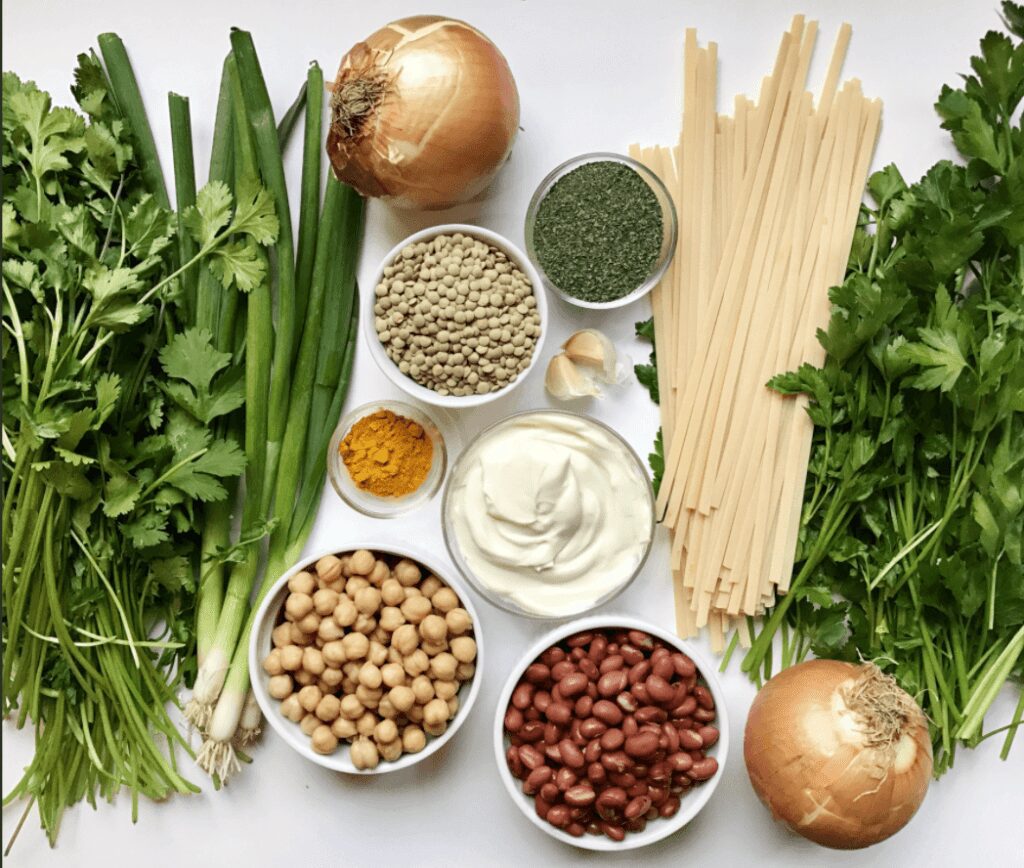
Directions
Step One
The most important thing in cooking Ash Reshteh or Ash e Reshteh is soaking the beans, which helps to cook them quickly in a short time. Let them soak for 5 to 6 hours and change their water twice so that the swelling of the beans also disappears.
Step Two
To prepare Persian soup noodles, first put the chickpeas in a strainer, wash them, and pour them into a pot. Pour 4 to 5 glasses of water into the pot and let the chickpeas cook over medium heat. Put the beans in another pot and pour 5 glasses of water on them.
Step Three
It’s better to put it on high heat until the water boils and then moderate the heat to cook the beans over time. Note that peas and beans should not be completely softened and crushed.
Step Four
As soon as you tested them on the teeth and they were cooked and kept their appearance, we should remove them from the heat and set them aside. Pour the lentils into a bowl, pour water over it, and let it soak for 30 minutes.
Step Five
Clean and wash the vegetables, put them in the drain, spread a clean cloth, and place the vegetables on the cloth. Let them dry and put them in the shredder or on the kitchen board. Chop them in a medium-size (vegetables should not be finely chopped) and set aside.
Step Six
Peel the onions and wash them, chop them on a kitchen board, pour oil into a pan and put them on low heat. Put the onions in a pan, fry them until they are golden, and then put them on a plate.
Step Seven
Peel garlic, then grate and fry them. Bake them until they become golden and pour them into a plate. To not lose the properties of garlic, it is recommended to fry it very little in oil.
Step Eight
Immediately check the pan. If there is no oil in the pan, pour more oil into it again and reduce the heat. Pour the dried mint into the pan and fry. As soon as the mints change colour slightly, remove the pan from the heat. We set it aside and fry it constantly so that the hot mint does not burn and does not turn black.
Step Nine
Pour 1/3 of the water into the pot that we have prepared for cooking the Persian Ash Reshteh, put the lid on the pot, and put it on high heat to boil faster. When the water was boiling, drain the lentils, then add them to the boiling water.
Step Ten
In the same way, pour the cooked chickpeas and beans into boiling water. Now, add the vegetables and immediately add half a spoon of salt to it (We add salt to preserve the green color.)
Step Eleven
Now, add half of the hot garlic, onion, hot mint and a little turmeric to the soup. Remember not to leave the lid on the pot; allow the vegetables to cook for 30 to 45 minutes on medium heat.
Step Twelve
After cooking the vegetables, cut the noodles in half and pour them into the soup. After 15 to 20 minutes, taste the soup, and if necessary, add salt to the soup again. If you want to add curd, You can also add curd to the soup in this step.

Step Thirteen
If you want to have both curd and sour soup, you can divide the soup into two parts, add vinegar to half of the soup, and add curd to the other half.
Step Fourteen
First, add the curd, test the soup, and then add a little salt with black pepper. When cooking the soup that you feel the water is low, use boiling water not negatively affect the taste of the soup.
How to Serve Ash Reshteh?
Put the prepared Aush Reshteh in the desired dish and decorate it with onion, hot garlic, hot mint and curd and enjoy.
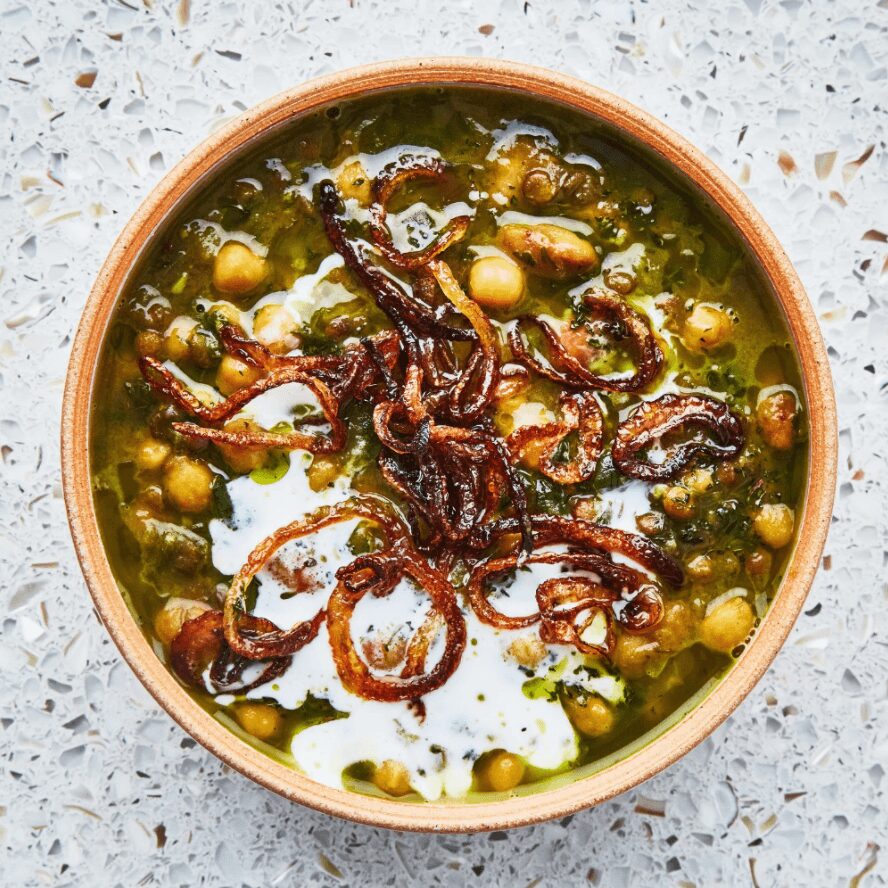
Ash Reshteh Cooking Tips
- For the noodles not to stick together and the ingredients to be cooked more quickly in the pot, the pot’s capacity should be larger than the volume of the Ash Reshteh.
- It is better to use plenty of hot onions for the soup.
- Try to use the best type of noodles.
- Be sure to test the salt in the noodle soup so that it does not become salty by pouring the curd soup.
- Be sure to boil the curd for 20 minutes in terms of health.
- Of course, the type of string also has a good effect on the placement of the soup. Chop the leeks separately from the other vegetables.
- Never leave the soup in the pot while cooking so that the soup does not turn brown.
- You can increase or decrease the number of beans in the soup.
- If you use pen water in the soup, reduce the amount of butter or oil.
Do not forget to make this ash e reshteh soup recipe and share it with us. If you also have any related questions about the Ash Reshteh recipe, please do not hesitate to ask.
Guidelines for Storage of Ash Reshteh
- For up to four days, keep in the refrigerator in an airtight container. The next day, ash resheh tastes even better, thus leftovers are almost always required.
- Heat again in a small skillet or pot over medium heat on the stovetop. If it has become too thick, you may thin it out with a little water. Additionally, you may reheat in a microwave.
- If you’ve opted to make a large amount, freeze any leftovers—this is what I generally do. After cooling, move the mixture to a sealed container and store it in the freezer for a maximum of two months. Thaw it overnight in the refrigerator or for a few hours on the countertop, then reheat according to the recipe.
Nowruz, the Persian New Year
In Persian and Iranian culture, ash rezzeh is more than simply a soup; it is notably celebrated during Nowruz, sometimes called Norooz, the “Persian New Year.” Celebrated on the spring equinox, which is often around March 20th, Nowruz is a time for family, loved ones, sharing delicious food, and hope.
Numerous other civilizations, such as Kurdish, those in Afghanistan, Pakistan, and some regions of Turkey, also celebrate it.
Beautiful symbolic implications of Ash Reshteh also exist in the Nowruz spirit. The noodles known as “reshteh” stand for the strands of life.
The noodles known as “reshteh” stand for the strands of life. The bright green herbs signify new beginnings and the arrival of spring, while the lentils promise wealth and plenty in the upcoming year.
On the eve of the final Wednesday of the solar year, Chaharshanbe Soori, is a pre-Nowruz event on which we customarily consume ash reshteh. Jumping over bonfires is a custom that represents wishing away illness, troubles, and bad luck from the past year in order to usher in a happy new one.
On Sizdeh Bedar, the final day of the Nowruz celebrations, we also consume ash. It literally means “13 the door” and occurs on the thirteenth day following the new year.
It’s a day to toast to good fortune, spend time outside with loved ones, and prepare a picnic that includes a large pot of Ash e Reshteh.
FAQs on Ash Reshteh Recipe
- What is Ash Reshteh made of?
Ash Reshteh is made of onion, kashk (whey or curd), garlic, reshteh (noodles), legumes like white beans, pinto beans, chickpeas, and lentils, and vegetables like spinach, leek, coriander, parsley, and dill.
- How many calories is Ash Reshteh?
Each cup of Ash Reshteh that is somehow 240 grams has 432 calories.
- What may be used in place of reshteh?
Replace one cup of dried udon noodles or spaghetti with the same amount of Reshteh.
Ash Reshteh Recipe; Delicious Persian Noodle Soup with Herbs & Beans
Course: Persian foodCuisine: Persian foodDifficulty: Medium5
servings1
hour30
minutes475
kcalAsh Reshteh is one of the traditional and popular Iranian dishes prepared with a variety of recipes in different cities of the country.
Ingredients
White beans ½ cup
Pinto beans ½ cup
Chickpeas 1 cup
Lentils 1 cup
Special vegetable soup 500 grams (Spinach or beet leaves: 100 g
Leek: 100 g Coriander: 100 g Parsley: 100 g Dill: 100 g)
Garlic 8 cloves
Onions 2 large
Dried mint 2 tablespoons
Noodles to taste
Curd to taste
Salt and black pepper to taste
Turmeric and oil
Directions
- The most important thing in cooking Ash Reshteh or Ash e Reshteh is soaking the beans, which helps to cook them quickly in a short time. Let them soak for 5 to 6 hours and change their water twice so that the swelling of the beans also disappears.
- To prepare Persian soup noodles, first put the chickpeas in a strainer, wash them, and pour them into a pot. Pour 4 to 5 glasses of water into the pot and let the chickpeas cook over medium heat. Put the beans in another pot and pour 5 glasses of water on them.
- It’s better to put it on high heat until the water boils and then moderate the heat to cook the beans over time. Note that peas and beans should not be completely softened and crushed.
- As soon as you tested them on the teeth and they were cooked and kept their appearance, we should remove them from the heat and set them aside. Pour the lentils into a bowl, pour water over it, and let it soak for 30 minutes.
- Clean and wash the vegetables, put them in the drain, spread a clean cloth, and place the vegetables on the cloth. Let them dry and put them in the shredder or on the kitchen board. Chop them in a medium-size (vegetables should not be finely chopped) and set aside.
- Peel the onions and wash them, chop them on a kitchen board, pour oil into a pan and put them on low heat. Put the onions in a pan, fry them until they are golden, and then put them on a plate.
- Peel garlic, then grate and fry them. Bake them until they become golden and pour them into a plate. To not lose the properties of garlic, it is recommended to fry it very little in oil.
- Immediately check the pan. If there is no oil in the pan, pour more oil into it again and reduce the heat. Pour the dried mint into the pan and fry. As soon as the mints change colour slightly, remove the pan from the heat. We set it aside and fry it constantly so that the hot mint does not burn and does not turn black.
- Pour 1/3 of the water into the pot that we have prepared for cooking the Persian Ash Reshteh, put the lid on the pot, and put it on high heat to boil faster. When the water was boiling, drain the lentils, then add them to the boiling water.
- In the same way, pour the cooked chickpeas and beans into boiling water. Now, add the vegetables and immediately add half a spoon of salt to it (We add salt to preserve the green color.)
- Now, add half of the hot garlic, onion, hot mint and a little turmeric to the soup. Remember not to leave the lid on the pot; allow the vegetables to cook for 30 to 45 minutes on medium heat.
- After cooking the vegetables, cut the noodles in half and pour them into the soup. After 15 to 20 minutes, taste the soup, and if necessary, add salt to the soup again. If you want to add curd, You can also add curd to the soup in this step.
- If you want to have both curd and sour soup, you can divide the soup into two parts, add vinegar to half of the soup, and add curd to the other half.
- First, add the curd, test the soup, and then add a little salt with black pepper. When cooking the soup that you feel the water is low, use boiling water not negatively affect the taste of the soup.
Recipe Video


